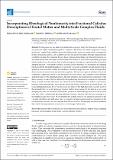Incorporating Rheological Nonlinearity into Fractional Calculus Descriptions of Fractal Matter and Multi-Scale Complex Fluids
Author(s)
Rathinaraj, Joshua David John; McKinley, Gareth H.; Keshavarz, Bavand
Downloadfractalfract-05-00174.pdf (3.713Mb)
Publisher with Creative Commons License
Publisher with Creative Commons License
Creative Commons Attribution
Terms of use
Metadata
Show full item recordAbstract
In this paper, we use ideas from fractional calculus to study the rheological response of soft materials under steady-shearing flow conditions. The linear viscoelastic properties of many multi-scale complex fluids exhibit a power-law behavior that spans over many orders of magnitude in time or frequency, and we can accurately describe this linear viscoelastic rheology using fractional constitutive models. By measuring the non-linear response during large step strain deformations, we also demonstrate that this class of soft materials often follows a time-strain separability principle, which enables us to characterize their nonlinear response through an experimentally determined damping function. To model the nonlinear response of these materials, we incorporate the damping function with the integral formulation of a fractional viscoelastic constitutive model and develop an analytical framework that enables the calculation of material properties such as the rate-dependent shear viscosity measured in steady-state shearing flows. We focus on a general subclass of fractional constitutive equations, known as the Fractional Maxwell Model, and consider several different analytical forms for the damping function. Through analytical and computational evaluations of the shear viscosity, we show that for sufficiently strong damping functions, for example, an exponential decay of fluid memory with strain, the observed shear-thinning behavior follows a power-law response with exponents that are set by the power-law indices of the linear fractional model. For weak damping functions, however, the power-law index of the high shear rate viscosity is set by the terminal behavior of the damping function itself at large strains. In the limit of a very weak damping function, the theoretical formulation predicts an unbounded growth of the shear stress with time and a continuously growing transient viscosity function that does not converge to a meaningful steady-state value. By determining the leading terms in our analytical solution for the viscosity at both low and high shear rates, we construct an approximate analytic expression for the rate-dependent viscosity. An error analysis shows that, for each of the damping functions considered, this closed-form expression is accurate over a wide range of shear rates.
Date issued
2021-10Department
Massachusetts Institute of Technology. Department of Mechanical Engineering; Hatsopoulos Microfluids Laboratory (Massachusetts Institute of Technology)Journal
Fractal and Fractional
Publisher
Multidisciplinary Digital Publishing Institute
Citation
Fractal and Fractional 5 (4): 174 (2021)
Version: Final published version
ISSN
2504-3110